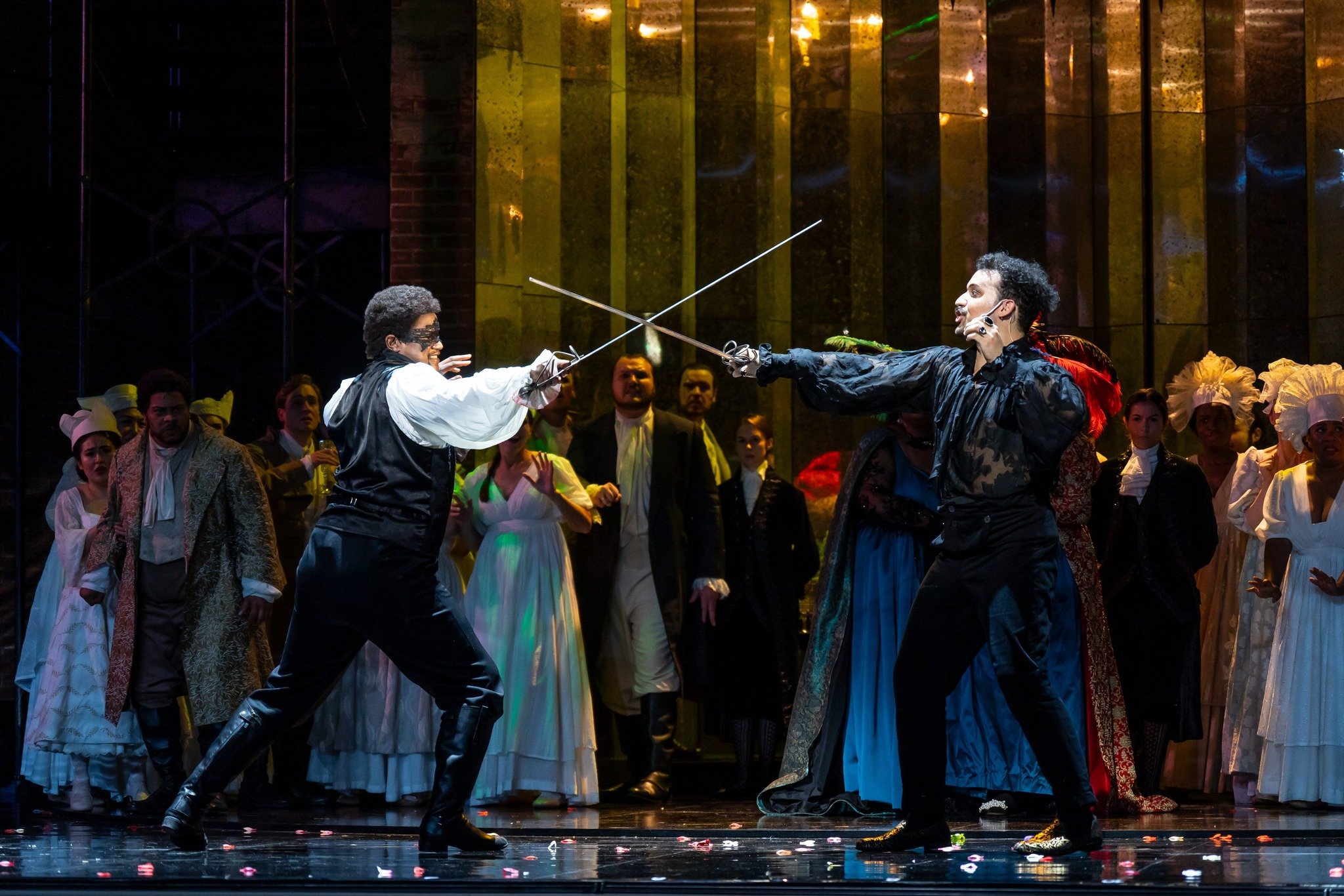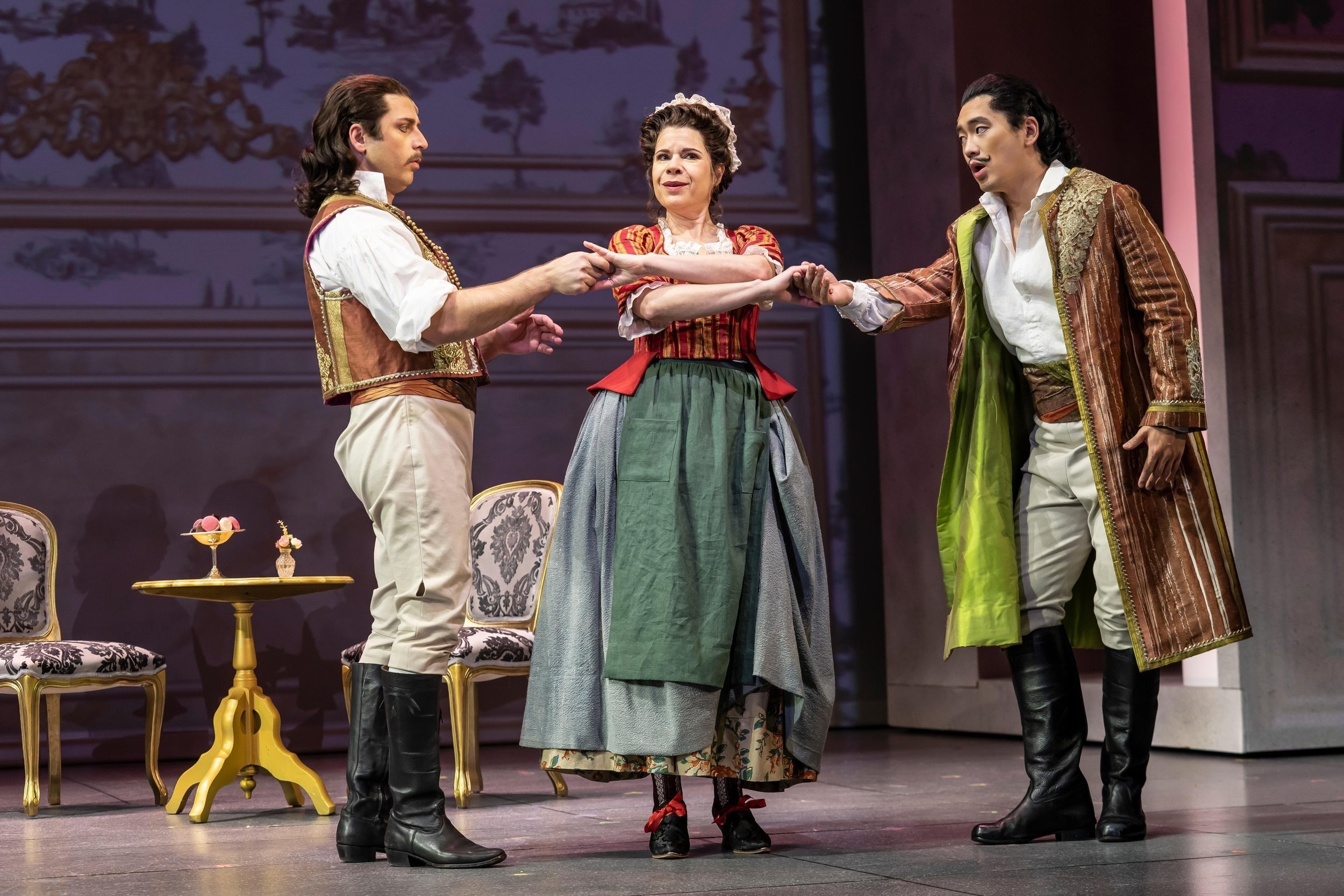Singing almost saves Don Giovanni at Wolf Trap

Last Friday, Wolf Trap Opera presented its sole mainstage production, Don Giovanni (they mounted two works at the Barns earlier). Mozart’s towering masterpiece brought out people in droves; despite a cast composed entirely of young unknowns, the house and the lawn were full, resoundingly demonstrating the region’s appetite for serious opera and strongly suggesting that more than one performance would’ve been welcome. Management hasn’t seen fit to offer anything more for years now; a real shame. That said, this flawed production set one’s teeth on edge in many ways.
First, the positive points. Don Giovanni calls for seven top-tier principals, every part vital. The company fielded uneven but enthusiastic artists, early in their careers, who gave it their all. Ensembles were particularly impressive, stronger singers carrying the others. The singers portraying Don Giovanni and his servant Leporello were of similar size and build, which made their identity-switching in Act II almost believable. Conductor Stephanie Rhodes Russell’s podium in the orchestra pit was raised to where she could be seen by everyone in the hall; rather than a distraction, this added frisson to the performance.
The standouts in the cast were Renée Richardson as Donna Anna, Andrew Gilstrap as Leporello, and, surprisingly Lunga Eric Hallam as Don Ottavio (“surprisingly” because the role is the least interesting of the seven and most tenors disdain it). But as his role is paired with Richardson’s their duets were the most musically-enjoyable of the evening. Her voice positively glistened in Or sai chi l'onore (though it showed some strain by Non mi dir in Act II). Hallam is a true vocal artist, with sensitive coloring, and lovely, tasteful ornaments on the reprises of his two arias. I’d love to hear him in larger roles, like Ferrando. Gilstrap had power and superior diction that stood out; Madamina (the “Catalog Aria”) was a highlight of the show.
Cory McGee in the title role was strong but not dominating, either dramatically or vocally. Eric Lindsey didn’t make much impression as the Commendatore, but (possibly though punched-up amplification) then rendered wonderful stentorian menace in the finale. Tiffany Townsend as Donna Elvira was questionable; the Handelian demands of the part seemed too much for her at first, the voice with a wobble approaching a trill, but by Act II and Mi tradì quell'alma ingrata, she had brought things nicely under control. Daniel Rich as Masetto seemed to have cotton in his voice, though he delivered good characterization. Denis Vélez struggled with the vocal demands of Zerlina, uncertain of pitch and occasionally running short of breath.
The main challenge in the Filene Center’s cavernous space is sound design. With every singer miked, it is crucial that the orchestra be properly miked as well; but violins were thin, timpani too loud, harpsichord (electronic) for the secco recitatives inaudible, and balances generally askew between stage and pit. This aspect needs its own tech rehearsal, as what came out was highly unsatisfactory. As for Russell, she had a genial, flowery approach to the score, glossing over sharp accents or sudden changes in dynamics. Again, the many difficult ensemble numbers came off successfully, but two-dimensionally.
Everything else was either head-scratching or disappointing. The locations in which the action is set are: the garden of the Commendatore, a public square outside Don Giovanni’s palace, the open country, Don Giovanni’s ballroom, outside Donna Elvira’s house, a graveyard, and Don Giovanni’s private room. What this big-budget production gave us instead was a tall circular brick turret that sat there throughout, suggesting none of the indicated settings. It swiveled around and opened outwards for the “ballroom” – the large cast crammed into a space roughly the size of my dining room – but otherwise just loomed grimly over the action. There was never a sense of different locations, let alone how they related to one another. And costumes were odd too; I’m still not clear what the masked people who wandered through some of the scenes were supposed to represent. It was not always clear who was a noble and who a peasant (though the two ladies’ and Don O’s costumes for the Act I ball looked like they were going to Mardi Gras.) Actually, a lot wasn’t always clear, because the lighting design left many characters in the shadows; and since we heard them through loudspeakers rather than locating them from where they sang onstage, the action in fast ensembles was likely impossible to follow for any newcomers to the piece.
And with all its vast resources, Wolf Trap entirely whiffed the tour de force of the opera. In the Act I ballroom scene, Mozart tosses off an unprecedented, almost jaw-dropping feat of musical genius, writing music for three separate small dance orchestras arrayed around the room, each playing different music in different meters, yet all somehow blending together. This was apparently a bridge too far for the company’s bean-counters, and the parts were just covered (inaudibly) by the pit orchestra, the musical highlight of the entire show going for nothing.
In the meantime, so many things came out of left field, random ideas from the director that served to muddy rather than clarify the action. The gallimaufry was everywhere including: Why were people wandering about in masks during the overture, suggesting mystery? What mystery? Why did Leporello begin the opera sitting on the ground for Notte e giorno faticar, where the music clearly depicts him pacing back and forth? Why couldn’t Don Giovanni at least mime playing the mandolin during his Serenade? (And to whom was he singing? No one present.) Donna Elvira is pregnant?? You’d think that might come up, at least in passing, during the many conversations between the various characters. And by the way, who eats dinner bare-chested?
Among the staff credits was someone listed as the show’s “Intimacy Coordinator.” Seeing this ahead of time, I’ll confess to looking forward to the performance a tad more than usual; Don Giovanni has many boundaries in this area that could be pushed. Alas, #MeToo has infiltrated our most sacred institutions; for Là ci darem, where we are supposed to see, for the first time, the title character’s legendary seduction skills in action, he and Zerlina are seated primly, about five feet from one another. When she finally allows him to get closer, what followed wouldn’t disturb a grade-school play. In Vedrai carino, where Zerlina ministers lovingly and carnally to her injured fiancé, she sings (of her heart and its physical location) “like a furnace it glows . . . all guard and cherish it, gold cannot buy it; soft 'tis and warm . . . feel how it throbs within,” etc., etc. You can probably imagine what goes on in most productions; but here, only at the very close of the aria did she gingerly place her lover’s hand up somewhere near her shoulder blade.
But the production’s most nonsensical, wrong-headed alteration in the story by far was our anti-hero’s comeuppance. The entire point of the tale is that Don Giovanni’s froideur and slippery machinations would always allow him to escape earthly punishment, so only a supernatural assault from the Commendatore’s Statue and the underworld would finally do the job. Here instead, although the Statue duly unleashed the furies who crawled menacingly about onstage under colored lights, Director John de los Santos was like, “ah, to heck with it,” and simply had Leporello stab his boss to death, rendering the previous quarter-hour of the opera pointless (as well as the final sextet). I don’t even know what to say.





